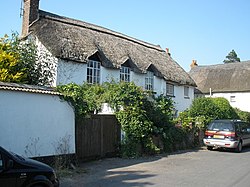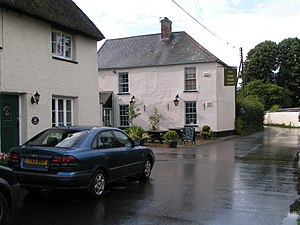Brampford Speke
| Brampford Speke | |
| Devon | |
|---|---|
 Pynes Cottage, Brampford Speke | |
| Location | |
| Grid reference: | SX926984 |
| Location: | 50°46’33"N, 3°31’28"W |
| Data | |
| Population: | 307 (2011) |
| Post town: | Exeter |
| Postcode: | EX5 |
| Local Government | |
Brampford Speke is a small village in eastern Devon, four miles to the north of Exeter. The population was recoeded at just 307 in 2011.
The village stands on red sandstone cliffs overlooking the River Exe. Its sister village of Upton Pyne lies to its southwest, and Stoke Canon is across the river, to the east. To the south is the hamlet of Cowley with its chapel of ease, which was formerly part of the ecclesiastical parish of Brampford Speke.
Brampford Speke has a Church of England parish church dedicated to St Peter.
There is a primary school in the heart of the village near the river Exe, which was built as a national school in 1867. A baptist chapel was built near the school in 1894.
The village also has a corner shop/tea room and a local pub, the Lazy Toad (formerly the Agricultural Inn). The village contains a number of fine houses, including Brampford House in the centre of the village, from which in past generations the squire who owned the village lived. There are some traditional cob and thatch cottages and farmhouses.
History
The village's name perhaps means 'bramble ford'. Speke is derived from the Anglo-Norman family Espek or Speke, lords of the manor from the reign of King Stephen (1135-1154). The Speke Chantry in Exeter Cathedral contains the effigy of Sir John Speke (1442-1518) of Heywood in Wembworthy and Brampford Speke in Devon and of Whitelackington in Somerset.
In 1815, the manor was purchased for the Northcote family, later Earls of Iddesleigh.
In 1847, the parish was the centre of a storm which caused a schism in the Church of England. George Cornelius Gorham was presented as vicar of the parish of Brampford Speke, but when examined by the Bishop of Exeter, Henry Phillpotts, Gorham was declared to hold Calvinist views on baptismal regeneration, which the Bishop rejected and he refused to permit his installation. Not to be held back by a bishop he considered in thrall to the errors of the Oxford Movement (which had taken hold in the senior levels of the Church), Gorham appealed to the Archbishop's court, the Canterbury Court of Arches, which upheld the bishop's decision, so he appealed again, to the Privy Council. The Privy Council was more receptive and Gorham was instituted as vicar of Brampford Speke. The furore over a secular court overturning the ruling of a church court led many leading llights in the Oxford Movement to abandon the Church of England and to become Roman Catholics.
As vicar, Gorham restored the church building, entirely rebuilding the tower, for which Bishop Phillpotts gave some money. The church's north aisle had been added in 1840. A marble tablet on the east wall of the south transept commemorates Gorham.
Brampford Speke was served by the Exe Valley line of the Great Western Railway, which opened on 1 May 1885, until the Beeching Axe of 7 October 1963 closed its Brampford Speke Halt. Both the old railway station and the old station house remain in residential use, and are situated across the river from the village. An iron footbridge over the river Exe connects a path from the school, down the cliff and across the meadow to the station. The current bridge is the third. The old railway embankment can be walked to Stoke Canon, whereas the line to Thorverton is now impassable due to collapsed bridges.
Outside links
| ("Wikimedia Commons" has material about Brampford Speke) |
References
- Orme, Nicholas: 'A guide to St. Peters Church, Brampford Speke' (N.I. & R.J. Orme, 1989) ISBN 0-9514816-0-6
